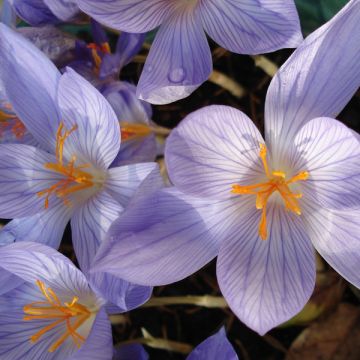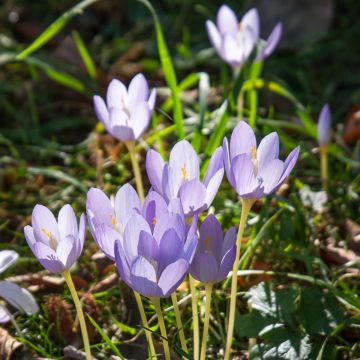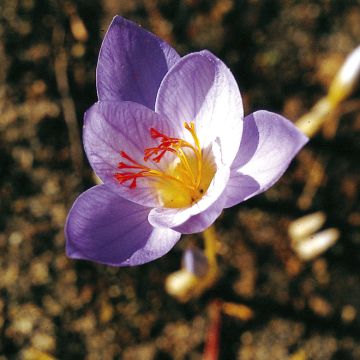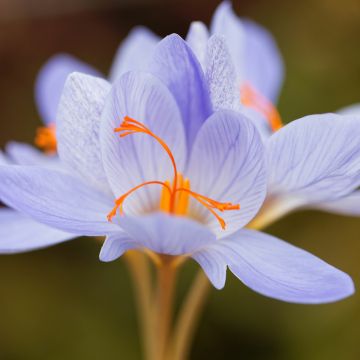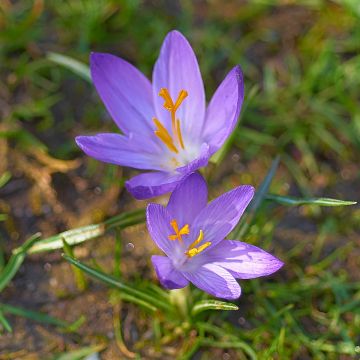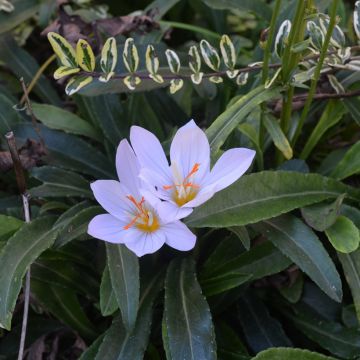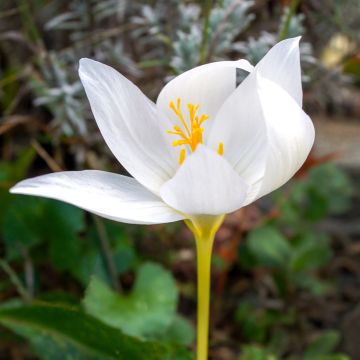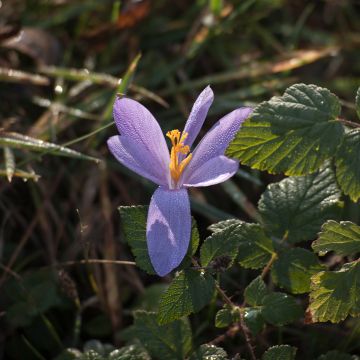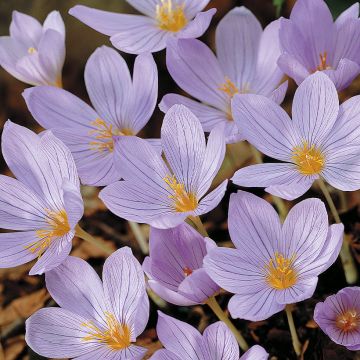

Crocus kotschyanus
Crocus kotschyanus
Crocus kotschyanus
Kotschy's Crocus
Special offer!
Receive a €20 voucher for any order over €90 (excluding delivery costs, credit notes, and plastic-free options)!
1- Add your favorite plants to your cart.
2- Once you have reached €90, confirm your order (you can even choose the delivery date!).
3- As soon as your order is shipped, you will receive an email containing your voucher code, valid for 3 months (90 days).
Your voucher is unique and can only be used once, for any order with a minimum value of €20, excluding delivery costs.
Can be combined with other current offers, non-divisible and non-refundable.
This plant carries a 6 months recovery warranty
More information
We guarantee the quality of our plants for a full growing cycle, and will replace at our expense any plant that fails to recover under normal climatic and planting conditions.

Would this plant suit my garden?
Set up your Plantfit profile →
Description
The Kotschy Crocus is a botanical species native to Turkey, the Caucasus, and Lebanon that blooms in early autumn, usually in October. Its flowers are not very large, but the plant multiplies very easily and its cultivation does not present any particular difficulty in well-drained soil, rather dry in summer. This species, often confused with the karduchorum Crocus, is characterised by flowers of more or less mauve to light pink colour with a yellow-circled throat. It can be planted in a rock garden, a gravel garden, a raised bed, at the base of deciduous shrubs, or in a planter.
The Kotschy Crocus, formerly known as Crocus zonatus, belongs to the iris family like all crocuses. Its natural distribution range extends from central to southern and northwestern Turkey to Syria and the northern and central parts of Lebanon. This species has been awarded the R.H.S. Award of Garden Merit. It freely self-seeds and multiplies spontaneously by producing bulbils.
In cultivation, this Kotschy Crocus blooms in October. It produces 10-12 cm tall flowers that emerge alone from the ground, while the leaves develop in late winter. The elongated cup-shaped flowers are composed of 6 petals whose colour can vary between pale lilac mauve and pale mauve-pink, finely veined with light violet. They open in a star shape, revealing a yellow-circled throat. The centre of the flower is occupied by a white style, divided into very thin yellow filaments. This style dominates yellow stamens with white anthers. The flowers close at night and in bad weather, and open widely in the sun. The foliage consists of fine linear, single, and alternate, medium green leaves, crossed by a white line. The "bulbs" here are corms covered by a tunic of parallel fibres. A corm is, in plant morphology, an underground storage organ that looks like a bulb but is formed by a swollen stem surrounded by a fibrous tunic.
The Kotschy Crocus adds a nice touch of colour in early autumn. It can be planted in rock gardens, or at the base of deciduous trees or shrubs. It will thrive and naturalise quickly in any well-drained soil, even rocky soil. Combine autumn crocuses with their spring cousins to enjoy multiple blooms throughout the year. Some ideas for combinations: with cyclamens, botanical daffodils, and other small spring bulbs like botanical tulips and grape hyacinths.
A tip about crocuses: their roots have the particular ability to contract like a spring, allowing the plant to settle at the ideal depth for the plant.
Report an error about the product description
Plant habit
Flowering
Foliage
Botanical data
Crocus
kotschyanus
Iridaceae
Kotschy's Crocus
Crocus zonatus
Caucasus
Other Autumn Crocuses
View all →Planting and care
Plant the small corms of Crocus kotschyanus before 20th September, in very well-drained soil, enriched with compost and sand, at a depth of 5-6 cm and spaced 8 cm apart or in groups of three every 15 to 20 cm. It is preferable to leave them in place. They will form increasingly floriferous clumps. Consider making a few pots for your terrace. Crocus kotschyanus grows in slightly acidic to slightly alkaline soils and prefers a sunny exposure that allows for full corolla opening. It can tolerate temperatures down to about -15°C (possibly more) and summer drought when it is dormant. The crocus requires no special maintenance. Be careful not to cut the foliage before it turns yellow. Corms are susceptible to excess moisture, which can cause them to rot during their dormant period. Rodents are fond of these corms, and snails and slugs feed on all aerial parts of the plant.
Planting period
Intended location
Care
This item has not been reviewed yet - be the first to leave a review about it.
Haven't found what you were looking for?
Hardiness is the lowest winter temperature a plant can endure without suffering serious damage or even dying. However, hardiness is affected by location (a sheltered area, such as a patio), protection (winter cover) and soil type (hardiness is improved by well-drained soil).

Photo Sharing Terms & Conditions
In order to encourage gardeners to interact and share their experiences, Promesse de fleurs offers various media enabling content to be uploaded onto its Site - in particular via the ‘Photo sharing’ module.
The User agrees to refrain from:
- Posting any content that is illegal, prejudicial, insulting, racist, inciteful to hatred, revisionist, contrary to public decency, that infringes on privacy or on the privacy rights of third parties, in particular the publicity rights of persons and goods, intellectual property rights, or the right to privacy.
- Submitting content on behalf of a third party;
- Impersonate the identity of a third party and/or publish any personal information about a third party;
In general, the User undertakes to refrain from any unethical behaviour.
All Content (in particular text, comments, files, images, photos, videos, creative works, etc.), which may be subject to property or intellectual property rights, image or other private rights, shall remain the property of the User, subject to the limited rights granted by the terms of the licence granted by Promesse de fleurs as stated below. Users are at liberty to publish or not to publish such Content on the Site, notably via the ‘Photo Sharing’ facility, and accept that this Content shall be made public and freely accessible, notably on the Internet.
Users further acknowledge, undertake to have ,and guarantee that they hold all necessary rights and permissions to publish such material on the Site, in particular with regard to the legislation in force pertaining to any privacy, property, intellectual property, image, or contractual rights, or rights of any other nature. By publishing such Content on the Site, Users acknowledge accepting full liability as publishers of the Content within the meaning of the law, and grant Promesse de fleurs, free of charge, an inclusive, worldwide licence for the said Content for the entire duration of its publication, including all reproduction, representation, up/downloading, displaying, performing, transmission, and storage rights.
Users also grant permission for their name to be linked to the Content and accept that this link may not always be made available.
By engaging in posting material, Users consent to their Content becoming automatically accessible on the Internet, in particular on other sites and/or blogs and/or web pages of the Promesse de fleurs site, including in particular social pages and the Promesse de fleurs catalogue.
Users may secure the removal of entrusted content free of charge by issuing a simple request via our contact form.
The flowering period indicated on our website applies to countries and regions located in USDA zone 8 (France, the United Kingdom, Ireland, the Netherlands, etc.)
It will vary according to where you live:
- In zones 9 to 10 (Italy, Spain, Greece, etc.), flowering will occur about 2 to 4 weeks earlier.
- In zones 6 to 7 (Germany, Poland, Slovenia, and lower mountainous regions), flowering will be delayed by 2 to 3 weeks.
- In zone 5 (Central Europe, Scandinavia), blooming will be delayed by 3 to 5 weeks.
In temperate climates, pruning of spring-flowering shrubs (forsythia, spireas, etc.) should be done just after flowering.
Pruning of summer-flowering shrubs (Indian Lilac, Perovskia, etc.) can be done in winter or spring.
In cold regions as well as with frost-sensitive plants, avoid pruning too early when severe frosts may still occur.
The planting period indicated on our website applies to countries and regions located in USDA zone 8 (France, United Kingdom, Ireland, Netherlands).
It will vary according to where you live:
- In Mediterranean zones (Marseille, Madrid, Milan, etc.), autumn and winter are the best planting periods.
- In continental zones (Strasbourg, Munich, Vienna, etc.), delay planting by 2 to 3 weeks in spring and bring it forward by 2 to 4 weeks in autumn.
- In mountainous regions (the Alps, Pyrenees, Carpathians, etc.), it is best to plant in late spring (May-June) or late summer (August-September).
The harvesting period indicated on our website applies to countries and regions in USDA zone 8 (France, England, Ireland, the Netherlands).
In colder areas (Scandinavia, Poland, Austria...) fruit and vegetable harvests are likely to be delayed by 3-4 weeks.
In warmer areas (Italy, Spain, Greece, etc.), harvesting will probably take place earlier, depending on weather conditions.
The sowing periods indicated on our website apply to countries and regions within USDA Zone 8 (France, UK, Ireland, Netherlands).
In colder areas (Scandinavia, Poland, Austria...), delay any outdoor sowing by 3-4 weeks, or sow under glass.
In warmer climes (Italy, Spain, Greece, etc.), bring outdoor sowing forward by a few weeks.






























